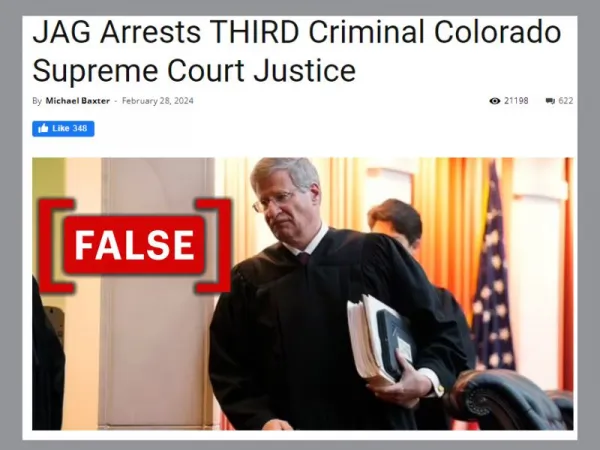By: Rohith Gutta
March 5 2024
No, U.S. Navy didn't arrest Colorado Supreme Court justice who ruled against Trump

Screenshot of the article on Real Raw News website that claims that Justice Richard Gabriel of the Colorado Supreme Court was arrested by the U.S. Navy (Source: Real Raw News/Modified by Logically Facts)
The Verdict False
U.S. Navy did not arrest Justice Richard Gabriel. The misinformation emerged from Real Raw News, a website notorious for peddling conspiracy theories.
What is the claim?
A Facebook user named Michael Moxon, notorious for disseminating misinformation, posted a screenshot from Real Raw News on February 28, 2024, with the headline, "JAG Arrests THIRD Colorado Supreme Court Justice."
The post displayed the text from an article published on the website, which claimed that the U.S. Navy JAG apprehended Justice Richard Gabriel of the Colorado Supreme Court on February 23 for unlawfully disqualifying Donald Trump. According to the article, Gabriel was the third Colorado Supreme Court justice to be arrested, following Justices Monica Marques and William Hood.
Citing alleged sources, the article stated that Marques and Hood had been transferred to Guantanamo Bay for interrogation, and Justice Gabriel was expected to be sent shortly. It also said that following Justice Wood's arrest, Gabriel fled to Belgium but was captured upon his return to the U.S. Archived versions of the Facebook post and the website article can be accessed here and here,
JAG refers to the Judge Advocate General's Corps of the U.S. Navy, which offers "comprehensive legal services to support naval and joint operations in pursuit of U.S. national security objectives." Justice Richard L. Gabriel has served on the Colorado Supreme Court since 2015.
Screenshot of the social media post claiming the arrest of Justice Richard Gabriel (Source: Facebook/Modified by Logically Facts)
However, this claim is false.
What did we find?
No reputable news sources are reporting the U.S. Navy's arrest of Justice Richard Gabriel. The U.S. Navy, its JAG, and the Colorado Supreme Court have not issued any statements regarding the arrest.
An AP News report dated December 23, 2023, stated that the Colorado Supreme Court ruled 4:3 to disqualify former U.S. President Donald Trump from the presidential race, citing the U.S. Constitution's insurrection clause. This decision removed him from the state’s primary ballot. Justice Gabriel was among the four justices who voted for Trump's disqualification. Colorado is among the states that have deemed Trump ineligible. However, according to another AP News report from March 5, the U.S. Supreme Court overturned these judgments on March 4, ruling against the application of the insurrection clause to declare him ineligible.
The claim originates from Real Raw News, a website that claims “to bring to light topics often ignored by others.” The site's disclaimer in its 'About Us' section states that its content includes "humor, parody, and satire." However, an analysis of the content on the website by Logically Facts has found that the website regularly publishes misinformation and conspiracy theories, often citing “highly placed anonymous sources,” including the U.S. Marines source they have cited in the present viral article. There is also no clarity on which articles are satire and which are factual.
According to the Posse Comitatus Act, the U.S. Military is prohibited from engaging in civil law enforcement unless explicitly authorized by legislation or the Constitution, as reported by the Brennan Center for Justice at New York University School of Law.
Similarly, there are no credible reports about the two other judges of the Colorado Supreme Court being sent to Guantanamo Bay for interrogation. Logically Facts has previously debunked the claim that the U.S. Military arrested Justice William Hood of the same court for disqualifying Trump.
Logically Facts has also contacted the Colorado Judicial Department for clarification. We will update this article once they respond.
The verdict
A screenshot from a website notorious for spreading misinformation and conspiracy theories is being circulated to allege that the U.S. Navy arrested Justice Richard Gabriel of the Colorado Supreme Court. There is no evidence to support these claims of arrest. Therefore, we have marked this claim as false.


